To Eat or Not to Eat?
Authors: Kristin Krokowski, Commercial Horticulture Educator
Rev: 10/2014
Item number: A4044
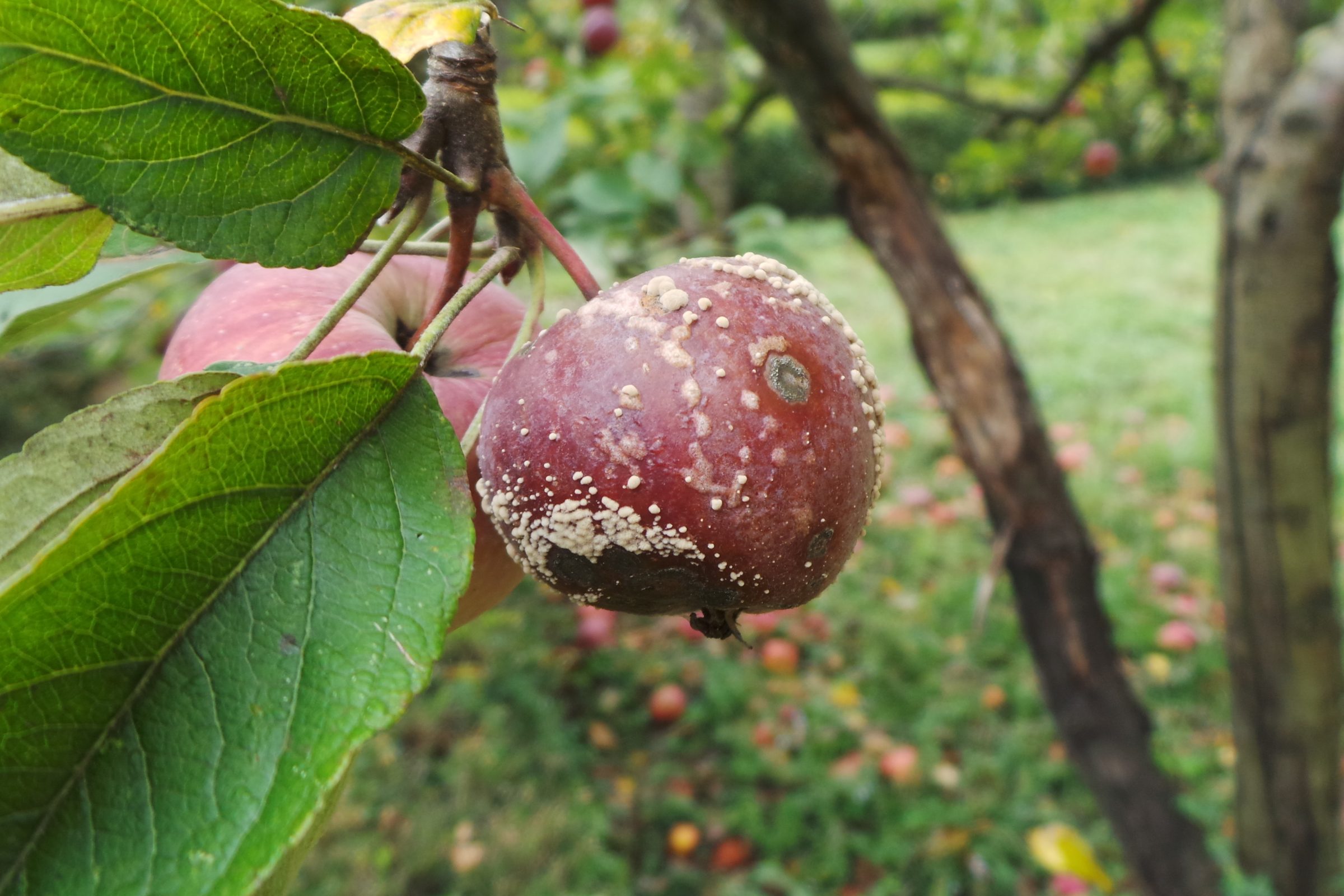
Fruit & Vegetable Spots
Spots on fruit and vegetables are caused by insects, disease, and physical damage. Causes of fruit and vegetable damage may vary, but the result is often the same.
Spots on the outer fruit skin may be of little concern, especially if the fruit will be cooked before it is consumed. Many fruit spots are simply blemishes on the outside of the skin. This is especially true of fruits with thick outer skins or rinds, such as pumpkins and watermelons.
Some fruit spots will penetrate the skin and affect the edible parts of the fruit or may cause cracking of the fruit’s outer surface or skin. Discard the fruit whenever the skin is broken or if the skin blemish is accompanied by a softening or discoloration.
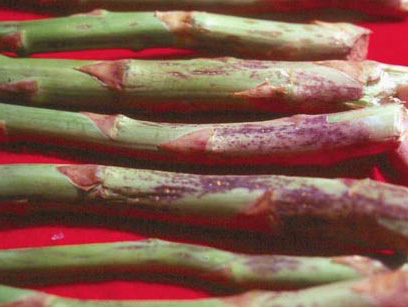
Elmer, W.H.
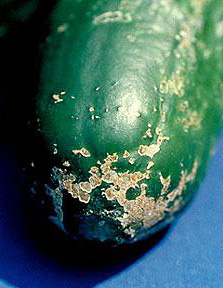
University of Maryland Extension/HGIC
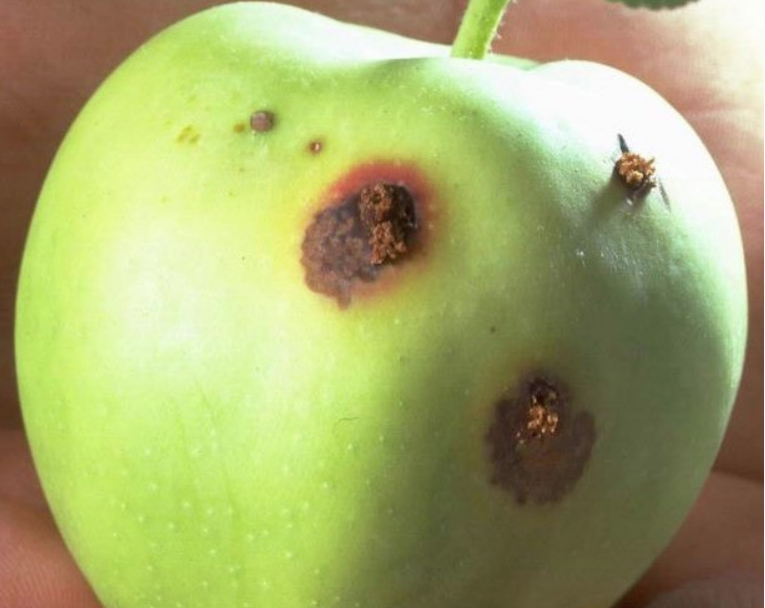
Mild scabby browning on the outside of many vegetables can be caused by weather damage or insect feeding. If the damage only affects the outer skin and does not penetrate into the vegetable’s flesh, the produce can be used. However, the affected area should be removed before the vegetable is consumed.
The produce should be discarded if the vegetable spots continue beneath the vegetable’s skin. These types of spots may indicate the existence of rots, mold, or vegetables with an off taste. Broken skin can create a way for human pathogens to enter the vegetable.
Crops commonly affected by fruit and vegetable spots
- Apples
- Melons
- Pears
- Pumpkins
- Asparagus
- Beans
- Cucumbers
- Leafy greens
- Peppers
- Tomatoes
Leaf Spots
Leaf spots are common on every kind of vegetable, but are especially problematic in cool, wet years. These spots can be a variety of colors, sizes, and shapes, but are of concern only on plants with edible leaves.
Leaf spots can be caused by insects, diseases, or the weather. Neither kind of leaf spot will cause foodborne illness. The greatest concern with leaf spots is cosmetic.
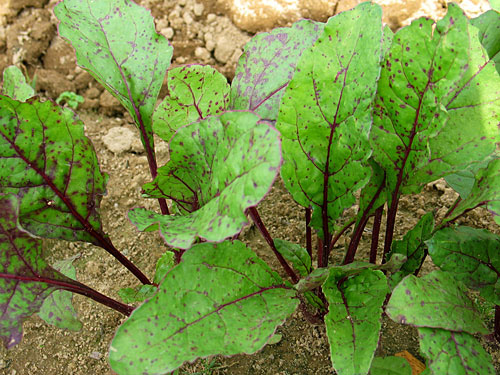
Margaret T. McGrath, Cornell University
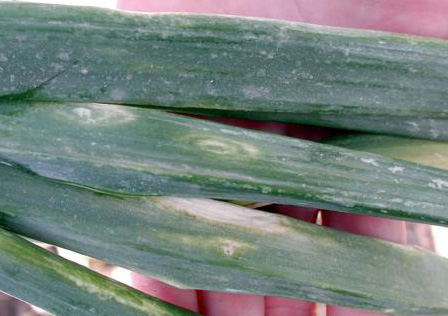
Melodie Putnam, Oregon State University
Leaves with a few spots or spots that are not easily apparent may be acceptable to consumers. However, remove leaves with many or large spots.
Other leaves that are part of the same bunch can still be used. Leaves with leaf spots may continue to decline in refrigeration. Inspect the leaves for signs of mold, slime, or other rots that may make them inedible before distribution.
Crops commonly affected by leaf spots
- Cabbage
- Chard
- Leafy greens
- Green onions
- Spinach
Odd Shapes
Perfectly shaped carrots or tomatoes may seem normal at the grocery store, but gardeners know it isn’t simple to produce picture-perfect fruits and vegetables. Many things can come between a fruit or vegetable and perfection, but few are cause for alarm.
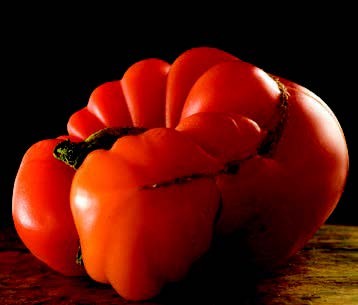
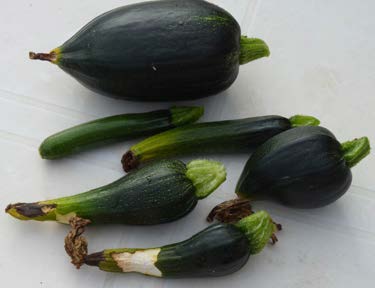
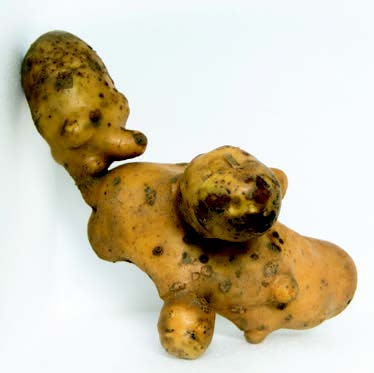
Soil quality can alter the way root crops grow. Imperfect pollination changes the shape of zucchini and berries, and environmental conditions can cause all sorts of strange shapes. The important thing to know is oddly shaped fruits and vegetables are still edible.
Although these strange-looking vegetables are edible, they tend to spoil more quickly than normally shaped produce, so keep an eye on them and use them quickly.
Crops commonly affected with odd shapes
- All crops
Mold
Many kinds of molds can affect fruits and vegetables. Some molds occur because of the growing conditions in the field and others occur during storage.
Molds can be a variety of colors, such as white, gray, black, tan, blue, and green, but they all signal the same thing: Plant tissue is being broken down.
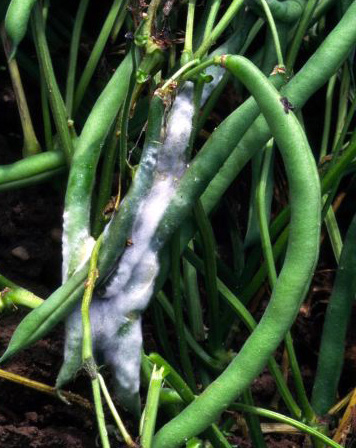
Bob Mulrooney, University of Delaware
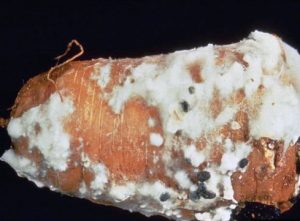
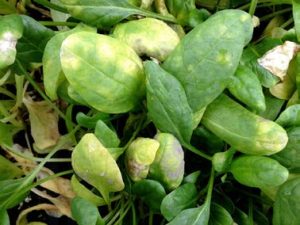
As the molds break down the fruit or vegetable, wounds are opened in the plant that can allow foodborne illness to enter. Discard all fruits and vegetables contaminated with mold.
It is also possible for mold to develop on fruits and vegetables during storage. Check all stored produce before distributing for signs of mold or decay.
Crops commonly affected by mold
- Apples
- Beans
- Berries
- Carrots
- Cucumber
- Leafy greens
- Melon
- Pears
- Peppers
- Potatoes
- Tomatoes
Rot
Rot on fruits and vegetables can be caused by many different things. Some insects or diseases cause damage that leads to rot. Weather conditions and improper handling of fruits and vegetables can lead to rot. Even if none of these things occur, fruits and vegetable will eventually rot.
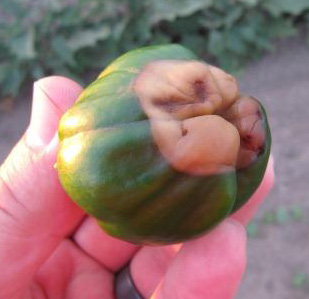
Dr. Matt Ruark, University of Wisconsin-Madison
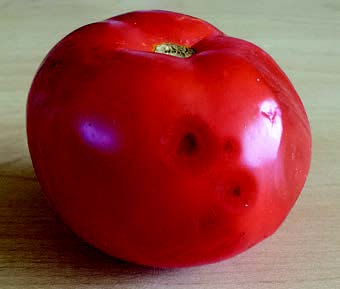
Rot is a natural process. In our own homes, we might simply cut off part of a fruit or vegetable that has begun to decay. However, it is not recommended that produce that has begun to rot be distributed. Rot and any other process, natural or not, that breaks the skin of a fruit or vegetable opens produce to the risk of contamination by a foodborne illness.
Fruit and vegetables that show signs of rot should be discarded. Ripe or overripe fruit should be monitored for signs of rot.
Crops commonly affected by rot
- All crops
Chewing Damage
People aren’t the only ones who like fruits and vegetables. Many critters will feed on everything from beets to squash.
Most chewing damage that isn’t done by worms and caterpillars is caused by members of the rodent family. Mice, voles, rabbits, and groundhogs are common culprits. It is especially common in drought years when other sources of moisture are limited.
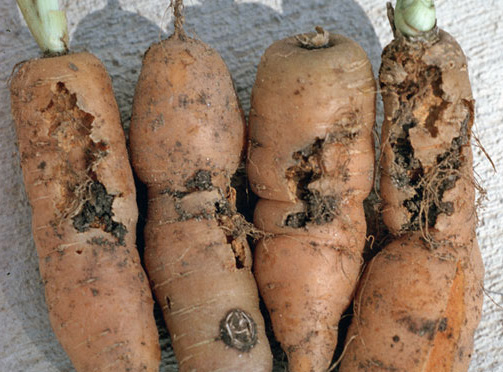
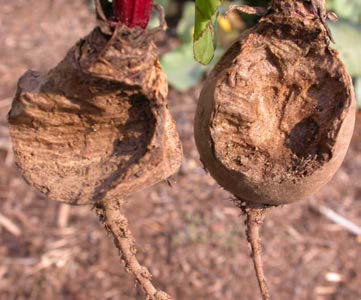
Rodent damage can be easily identified by the teeth marks left behind. They chew with their front teeth, leaving two small grooves with a raised area in between. The size of the grooves will depend on the size of the animal.
Most vegetables will callus over chewing damage, creating a new outer skin that is similar to the rest of the vegetable. Regardless of how well the skin is callused, fruits or vegetables with chewing damage should not be distributed.
Crops commonly affected by chewing damage
- Beets
- Carrots
- Melons
- Potatoes
- Pumpkins
- Squash
Worms and Maggots
Worms and maggots attack many different fruit and vegetable crops. Some worms feed above the ground on leaves and others feed below ground. Maggots tend to feed by burrowing into the host plant.
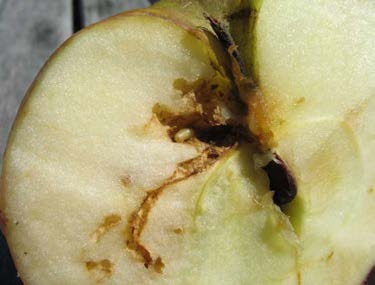
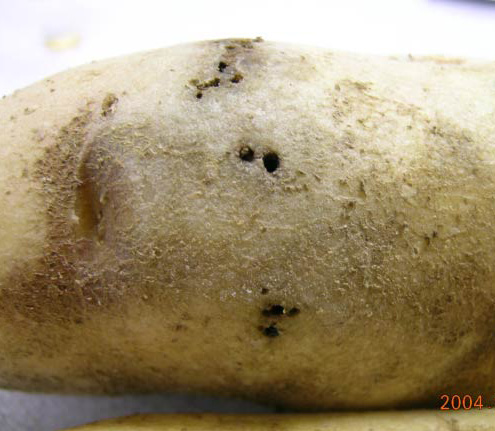
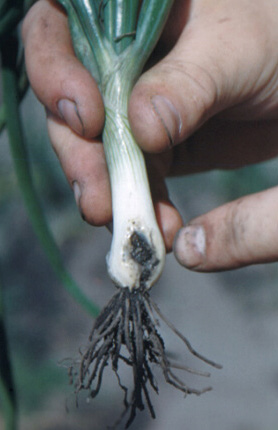
Worms and maggots pierce the outer skin or leaf surface of the crops they attack. Produce with maggot damage should be discarded. There are many soft rots that may also cause damage to the produce once maggots have infested the produce.
Produce with worm damage should be evaluated. Superficial damage to the outside of root crops (e.g., potatoes, radishes, and turnips) is not a food safety risk. Produce with internal damage should be discarded.
Crops commonly affected by chewing worms and maggots
- Apples
- Broccoli
- Cabbage
- Carrots
- Cauliflower
- Onions
- Potatoes
- Radishes
- Turnips
Caterpillar Damage
Caterpillars come in all shapes and sizes. You are more likely to see the damage from caterpillar feeding, rather than the caterpillars themselves.
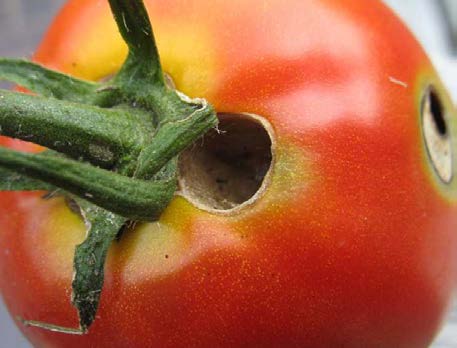
Caterpillars feed on a variety of fruits and vegetables. They damage plants by eating or chewing parts of the plant. Leafy vegetables usually have chewing damage from caterpillars. Other kinds of produce, like apples and tomatoes, will have holes. These holes may be where the caterpillar entered the fruit to feed on the inside or it may be the result of the caterpillar feeding on the outside of the fruit or vegetable.
Cabbages and other leafy vegetables with chewing damage can often be salvaged by removing the affected leaves. However, other types of fruits and vegetables with caterpillar feeding damage should be thrown away. When caterpillars break the skin of a fruit, there is the potential for foodborne illness.
Crops commonly affected by caterpillar damage
- Apples
- Asparagus
- Beans
- Cabbage
- Lettuce
- Spinach
- Sweet corn
- Tomatoes
- Peppers
Leafminers
Leafminer damage takes different forms. The most common damage is long snake-like trails along the leaf of beet, turnip, chard, spinach, and other leafy green plants. Damage can also look like leaf blisters or blotches.
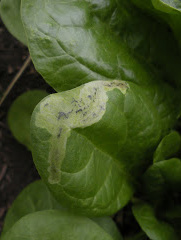
Leafminer damage is caused by the immature maggot stage of leafminer flies. These flies lay their eggs on or near a target host plant. As soon as the eggs hatch, the maggots burrow into the leaves. Leafminer maggots feed on the part of the leaf between the upper and lower leaf surface. Once they have completed their development, the maggots either remain in the leaf or drop to the ground.
Leafy greens containing leafminer trails should be discarded. Not only is there the potential for maggots in the leaves, but emptied areas may have insect feces. Discarding them is the safest option even if there are no known human health risks associated with eating these greens. Because this damage is to the inside of the leaves, the area cannot be cleaned or washed. Only greens with obvious trails need to be discarded.
Crops commonly affected by leafminers
- Leafy greens
Loopers
Loopers (also called cabbage loopers or cabbage worms), are a pest on many fall crops like broccoli, Brussels sprouts, cabbage, cauliflower, celery, and leafy greens. Loopers are about 1.5 inches long, light to dark green, and sometimes have white stripes on their backs or on their sides.
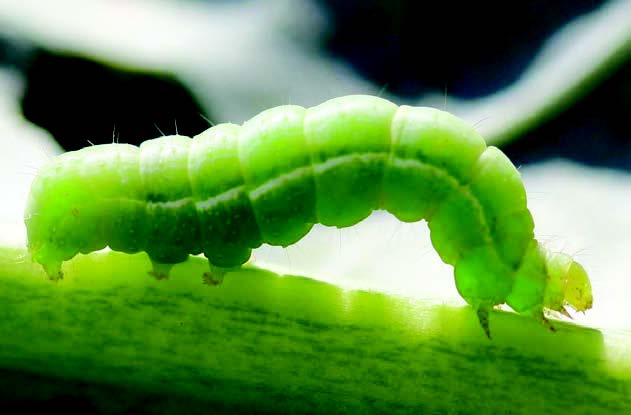
Loopers damage crops by chewing. They can be difficult to control because when the loopers are small they stay on the inside of the vegetables and their chewing damage isn’t noticeable. Broccoli, cabbage, and cauliflower are often harvested before the damage is apparent.
Although you or your consumers may not notice the chewing damage, the loopers may be present. The easiest way to avoid cooking or eating the loopers is by submerging the produce in water after it is cut. This will also help to wash off any remaining soil or residue on the vegetables. The loopers will float to the top and can be discarded before cooking. If consumers skip this step, loopers can also be discarded after cooking. Loopers pose no danger if accidentally eaten.
Crops commonly affected by loopers
- Broccoli
- Brussels sprouts
- Cabbage
- Cauliflower
- Celery
- Leafy greens
Food Safety Guidelines for Less-than-Perfect Produce
Fruit & Vegetable Spots
Pantry Recommendations:
Discard the fruit whenever the skin is broken or if the skin blemish is accompanied by a softening or discoloration of the area. The vegetable should be discarded if the spots continue beneath its skin.
Consumer Recommendation:
Spots on the outer fruit skin are of little concern, especially if the fruit will be cooked before it is consumed. If the damage only affects the vegetable’s outer skin and does not penetrate into it’s flesh, the produce can be used.
Leaf Spots
Pantry Recommendations:
Leaves with a few spots or spots that are not easily apparent may be acceptable to consumers. However, remove leaves with many or large spots.
Consumer Recommendation:
Leaf spots will not cause foodborne illness. The greatest concern with leaf spots is cosmetic.
Odd Shapes
Pantry Recommendations:
Oddly shaped fruits and vegetables are still edible.
Consumer Recommendation:
Although these strange-looking vegetables are edible, they tend to spoil more quickly than normally shaped produce, so keep an eye on them and use them quickly.
Mold
Pantry Recommendations:
Discard all fruits and vegetables contaminated with mold.
Consumer Recommendation:
It is possible for mold to develop on fruits and vegetables during storage. Check all stored produce before it is distributed.
Rot
Pantry Recommendations:
Fruit and vegetables that show signs of rot should be discarded.
Consumer Recommendation:
Rot and any other process that breaks the skin of a fruit or vegetable opens produce to the risk of contamination by a foodborne illness.
Chewing Damage
Pantry Recommendations:
Do not distribute fruits and vegetables with chewing damage.
Consumer Recommendation:
Rodent damage can be easily identified by the teeth marks left behind.
Worms and Maggots
Pantry Recommendations:
Produce with internal damage should be discarded.
Consumer Recommendation:
Superficial damage to the outside of root crops (e.g., potatoes, radishes, and turnips) is not a food safety risk.
Caterpillar Damage
Pantry Recommendations:
Cabbages and other leafy vegetables with chewing damage can often be salvaged by removing the affected leaves. Other fruits and vegetables with caterpillar feeding damage should be thrown away.
Consumer Recommendation:
Remove parts of leafy vegetables affected by caterpillar damage.
Leafminers
Pantry Recommendations:
Do not distribute leafy greens containing leafminer trails.
Consumer Recommendation:
Leafy greens containing leafminer trails should be discarded. Not only is there the potential for maggots to be in the leaves, but the trails left behind may contain insect feces.
Loopers
Pantry Recommendations:
Loopers pose no danger if accidentally eaten.
Consumer Recommendation:
The easiest way to avoid cooking or eating the loopers is to submerge the produce in water after it is cut.





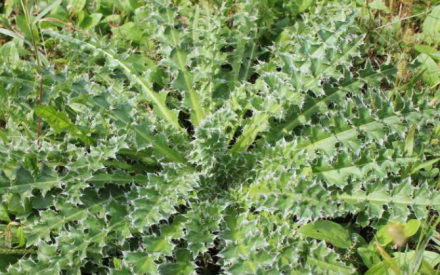 Musk Thistle - Carduus nutans
Musk Thistle - Carduus nutans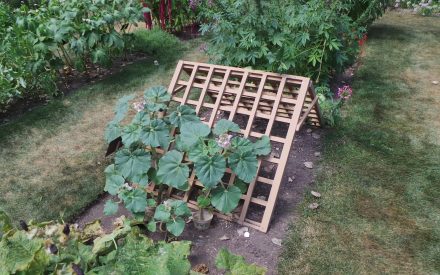 Trellising, Staking and Caging - Vertical Gardening Techniques for Vine-Type Vegetables
Trellising, Staking and Caging - Vertical Gardening Techniques for Vine-Type Vegetables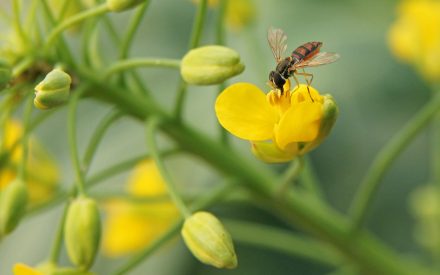 Hover, Flower or Syrphid Flies (Syrphidae)
Hover, Flower or Syrphid Flies (Syrphidae) Arkansas or Thread-leaf Blue Star, Amsonia hubrichtii
Arkansas or Thread-leaf Blue Star, Amsonia hubrichtii


